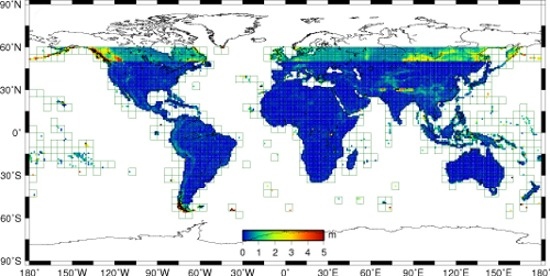Caveats Concerning the Use of SRTM DEM Version 4.1 (CGIAR-CSI)
Abstract
:1. Introduction
2. SRTM DEM Products
2.1. NASA/NGA SRTM Versions
2.2. CGIAR-CSI SRTM Versions
2.3. Expected Differences between NASA and CGIAR-CSI SRTM Products
3. Methods
4. Results
4.1. SRTM Product Inter-Comparison
4.2. Causes of the Observed Elevation Differences
5. Conclusions
- Above latitude 50°N and below 50°S, the SRTM-NASA-v2.1 product is to be preferred to the SRTM-CGIAR-v4.1 one.
- Between latitude 50°N and below 50°S, the SRTM-CGIAR-v4.1 may be preferable to the SRTM-NASA-v2.1, depending on the quality of the hole-filling, except between latitude 30°N and 31°N, and longitude 60°E and 90°E (see Section 4.1 for a list of corresponding SRTM-CGIAR-v4.1 tiles). Within this region, if the SRTM-NASA-v2.1 product exhibits an unacceptably high number of voids, the SRTM-CGIAR-v4.1 product can still be used, although an editing of the latter is required to compensate for the geolocation errors detailed in Section 4.1.
Acknowledgments
Conflicts of Interest
References
- Farr, T.G.; Rosen, P.A.; Caro, E.; Crippen, R.; Duren, R.; Hensley, S.; Kobrick, M.; Paller, M.; Rodriguez, E.; Roth, L.; et al. The Shuttle Radar Topography Mission. Rev. Geophys. 2007, 45, 1–33. [Google Scholar] [CrossRef]
- Yang, L.; Meng, X.; Zhang, X. SRTM DEM and its application advances. Int. J. Remote Sens. 2011, 32, 3875–3896. [Google Scholar]
- Zandbergen, P. Applications of Shuttle Radar Topography Mission elevation data. Geogr. Compass 2008, 2, 1404–1431. [Google Scholar] [CrossRef]
- Massonnet, D.; Feigl, K. Radar interferometry and its application to changes in the Earth’s surface. Rev. Geophys. 1998, 36, 441–500. [Google Scholar] [CrossRef]
- Farr, T.G.; Kobrick, M. Shuttle Radar Topography Mission produces a wealth of data. Eos Trans. AGU 2000, 81, 583–585. [Google Scholar] [CrossRef]
- Jarvis, A.; Reuter, H.I.; Nelson, A.; Guevara, E. Hole-Filled SRTM for the Globe Version 4.1. 2008. Available online: http://www.cgiar-csi.org/data/srtm-90m-digital-elevation-database-v4-1 (accessed on 10 August 2016).
- Shuttle Radar Topography Mission, 3 Arc Second, Version 2.1. Available online: http://dds.cr.usgs.gov/srtm/version2_1/SRTM3/ (accessed on 10 August 2016).
- SRTM Quick Guide. Available online: https://lpdaac.usgs.gov/sites/default/files/public/measures/docs/SRTM%20Quick%20Guide.pdf (accessed on 10 August 2016).
- Slater, J.A.; Garvey, G.; Johnston, C.; Haase, J.; Heady, B.; Kroenung, G.; Little, J. The SRTM data “Finishing” process and products. Photogramm. Eng. Remote Sens. 2006, 72, 237–247. [Google Scholar] [CrossRef]
- Performance Specification Digital Terrain Elevation Data (DTED). 2000; MIL-PRF-89020B. Available online: https://dds.cr.usgs.gov/srtm/version2_1/Documentation/MIL-PDF-89020B.pdf (accessed on 6 September 2016).
- Gamache, M. Free and Low Cost Datasets for International Mountain Cartography. Available online: http://www.terrainmap.com/downloads/Gamache_final_web.pdf (accessed on 10 August 2016).
- SRTM Topography. Available online: http://dds.cr.usgs.gov/srtm/version2_1/Documentation/SRTM_Topo.pdf/ (accessed on 10 August 2016).
- Shuttle Radar Topography Mission. Available online: http://glcfapp.glcf.umd.edu/data/srtm/description.shtml (accessed on 10 August 2016).
- Grohman, G.; Kroenung, G.; Strebeck, J. Filling SRTM voids: The Delta Surface Fill method. Photogramm. Eng. Remote Sens. 2006, 72, 213–216. [Google Scholar]
- Reuter, H.I.; Nelson, A.; Jarvis, A. An evaluation of void filling interpolation methods for SRTM data. Int. J. Geogr. Inf. Sci. 2007, 21, 983–1008. [Google Scholar] [CrossRef]
- Hole-Filled SRTM for the Globe Version 4.1 (Harvest Choice Mirror, USA). Available online: http://droppr.org/srtm/v4.1/6_5x5_TIFs/ (accessed on 10 August 2016).
- Hole-Filled SRTM for the Globe Version 4.1 (GISLAB Mirror, RUS). Available online: http://gis-lab.info/data/srtm-tif/ (accessed on 10 August 2016).
- Hole-Filled SRTM for the Globe Version 4.1 (JRC Mirror, IT). Available online: http://esdac.jrc.ec.europa.eu/projects/srtmshuttle-radar-topogr (accessed on 10 August 2016).
- Mouratidis, A.; Briole, P.; Katsambalos, K. SRTM 3″ DEM (versions 1, 2, 3, 4) validation by means of extensive kinematic GPS measurements: A case study form North Greece. Int. J. Remote Sens. 2010, 31, 6205–6222. [Google Scholar] [CrossRef]
- Rexer, M.; Hirt, C. Comparison of free high-resolution digital elevation data sets (ASTER GDEM2, SRTM v2.1/v4.1) and validation against accurate heights from the Australian National Gravity Database. Aust. J. Earth Sci. 2014, 61, 213–226. [Google Scholar] [CrossRef]
- USGS NED 1 Arc-Second n53w118 1 × 1 Degree GridFloat. US Geological Survey: Reston, VA. Available online: http://nationalmap.gov/elevation.html/ (accessed on 10 August 2016).
- Wessel, P.; Smith, W.H.F. New, improved version of the generic mapping tools released. EOS Trans. AGU 1998, 79, 579. [Google Scholar] [CrossRef]
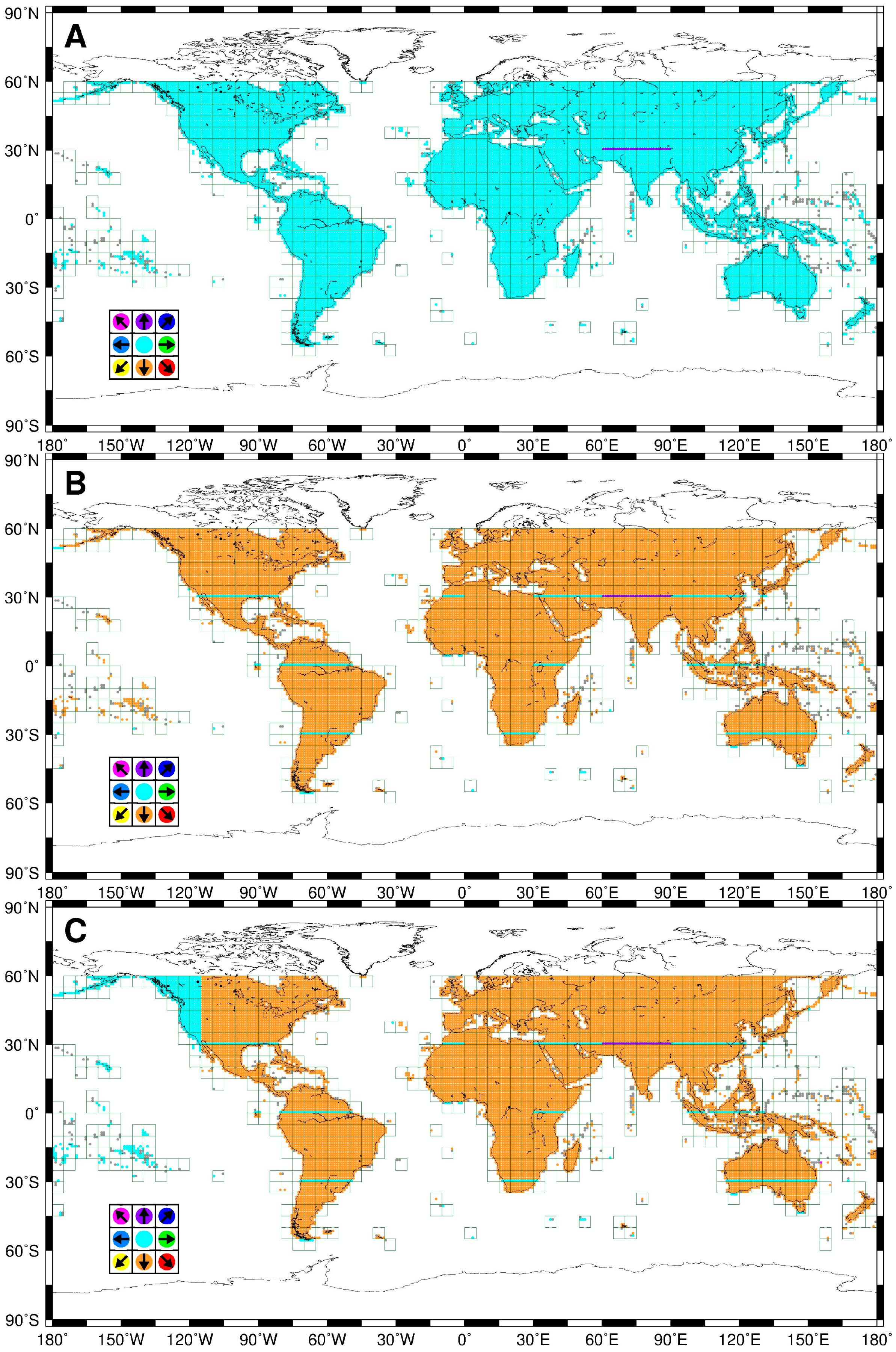
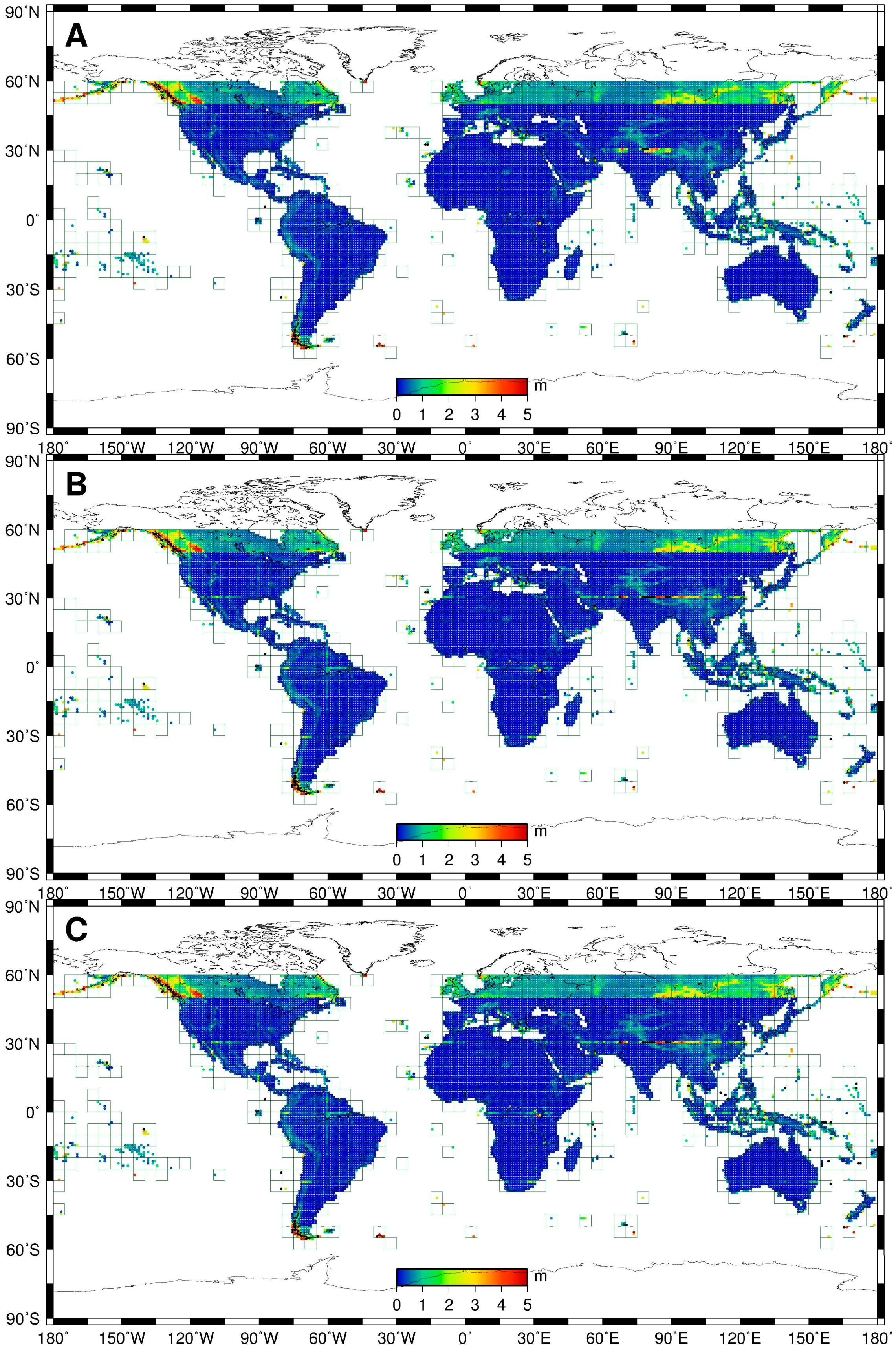
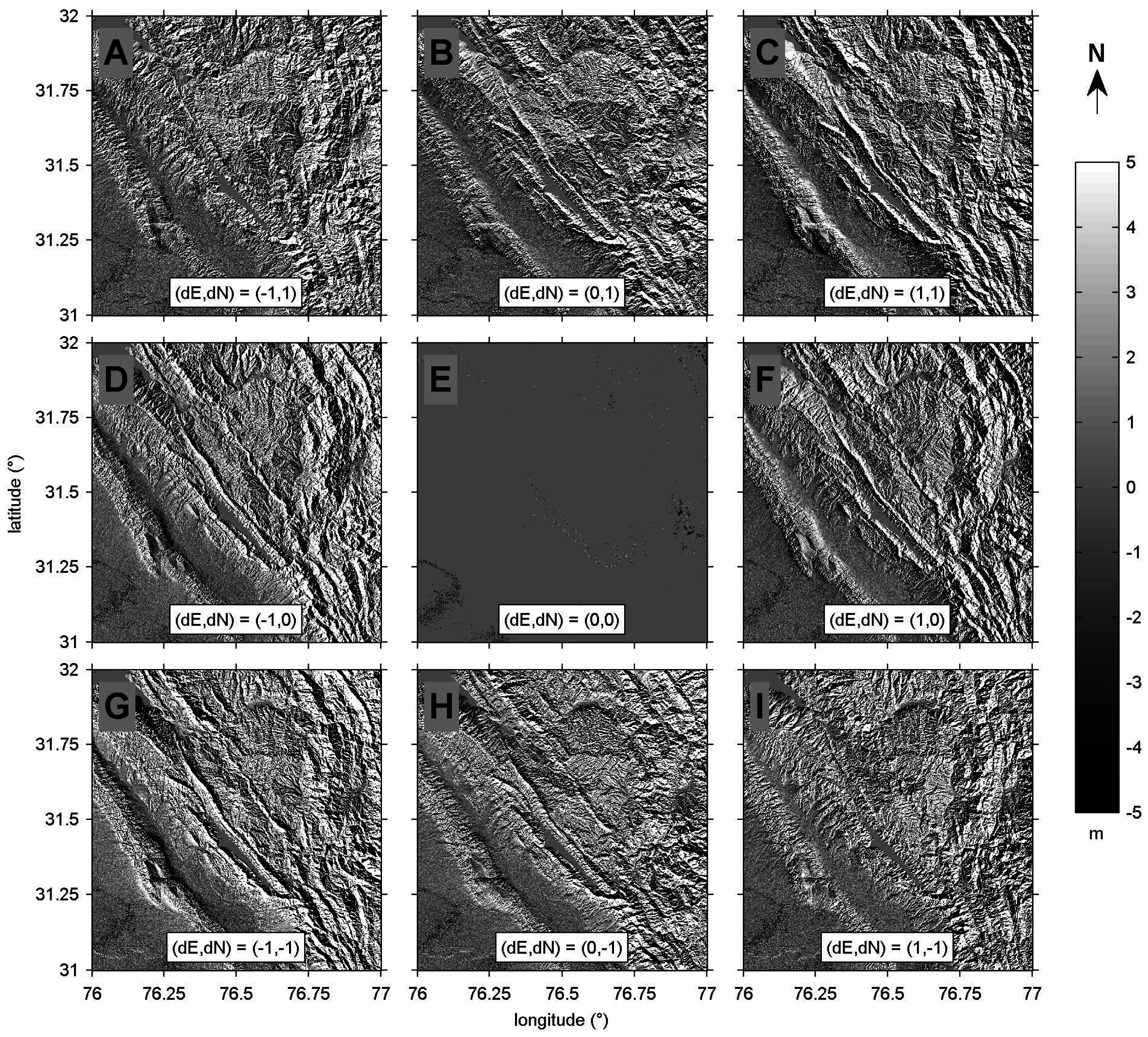
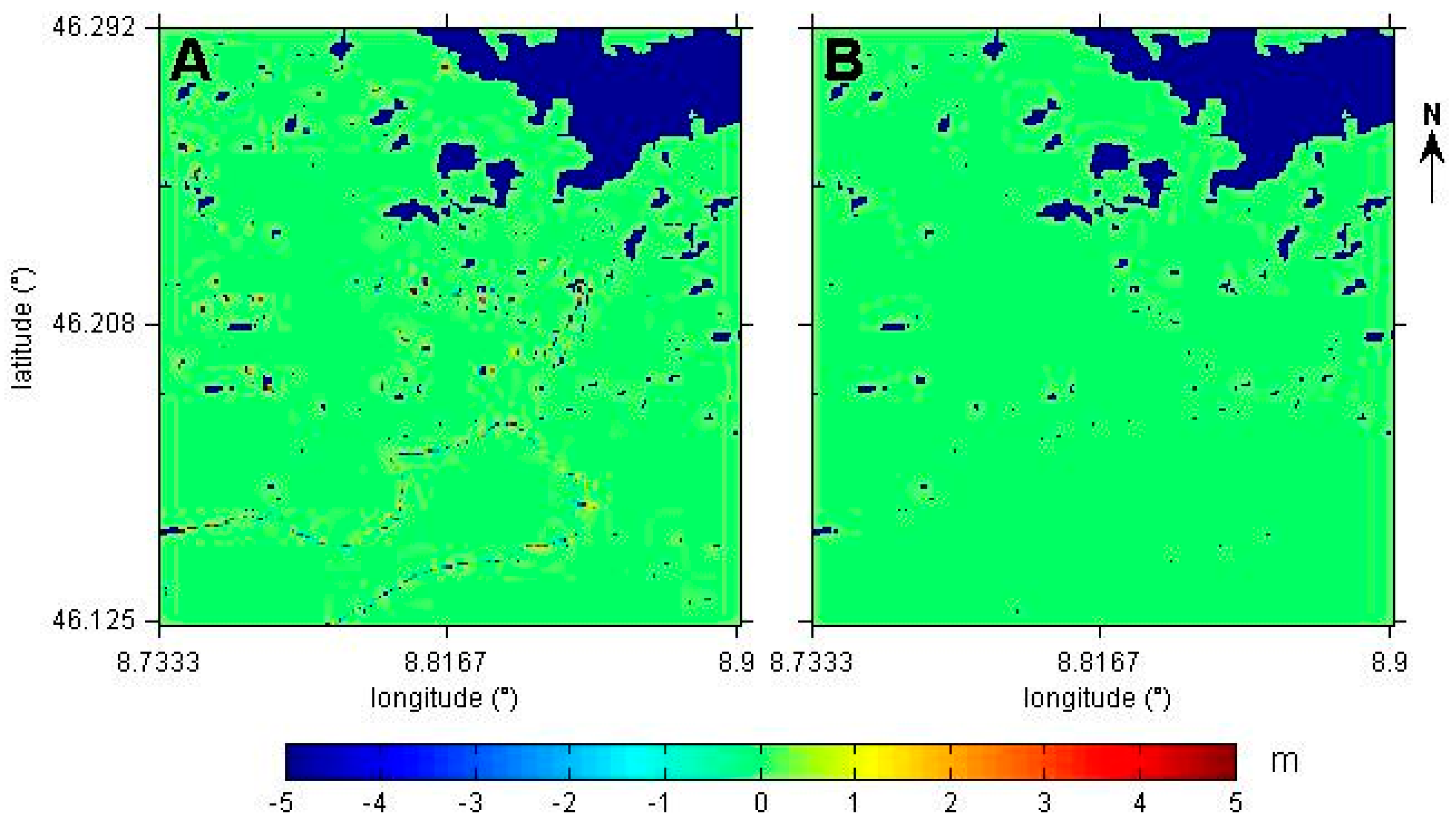
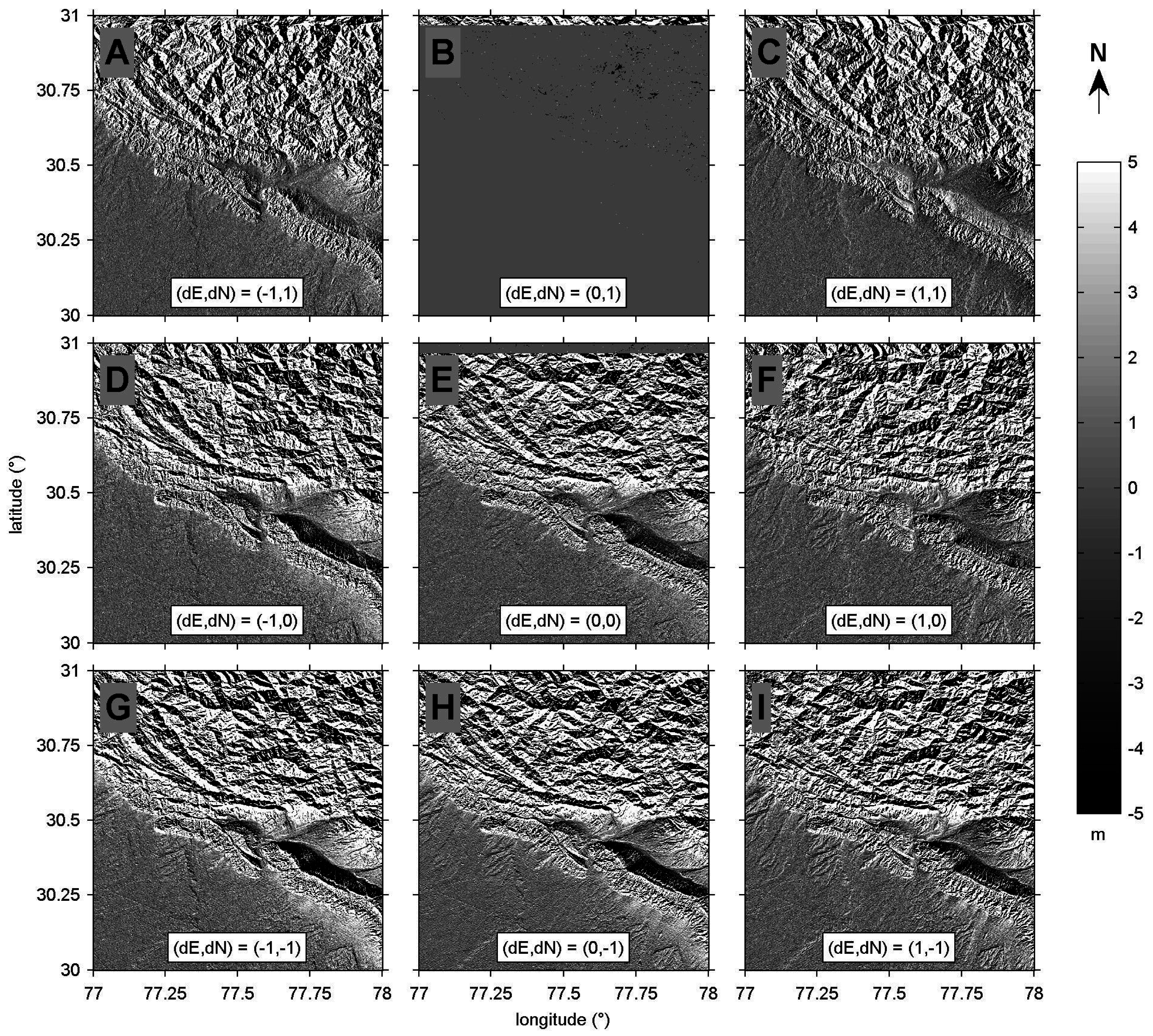
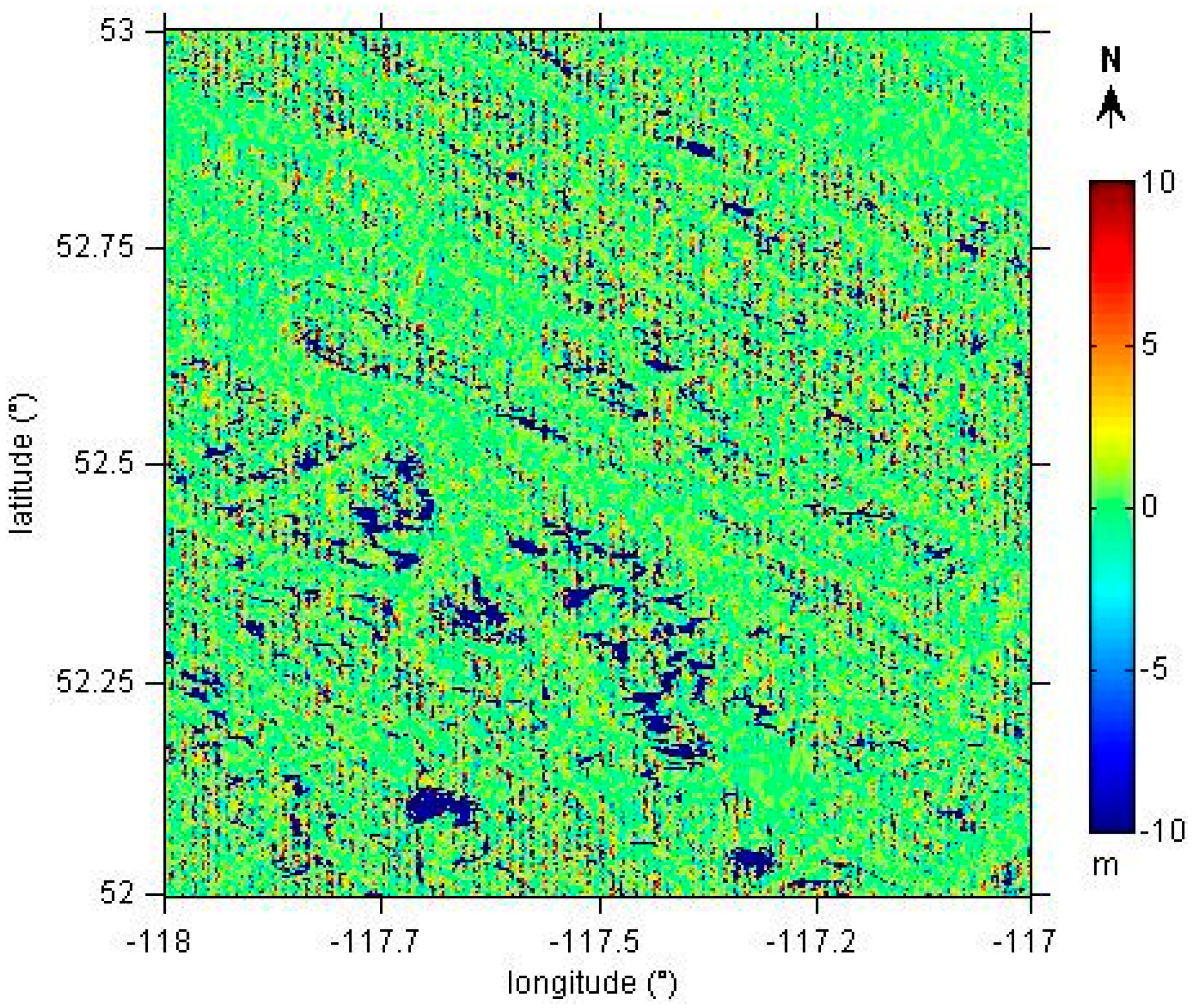
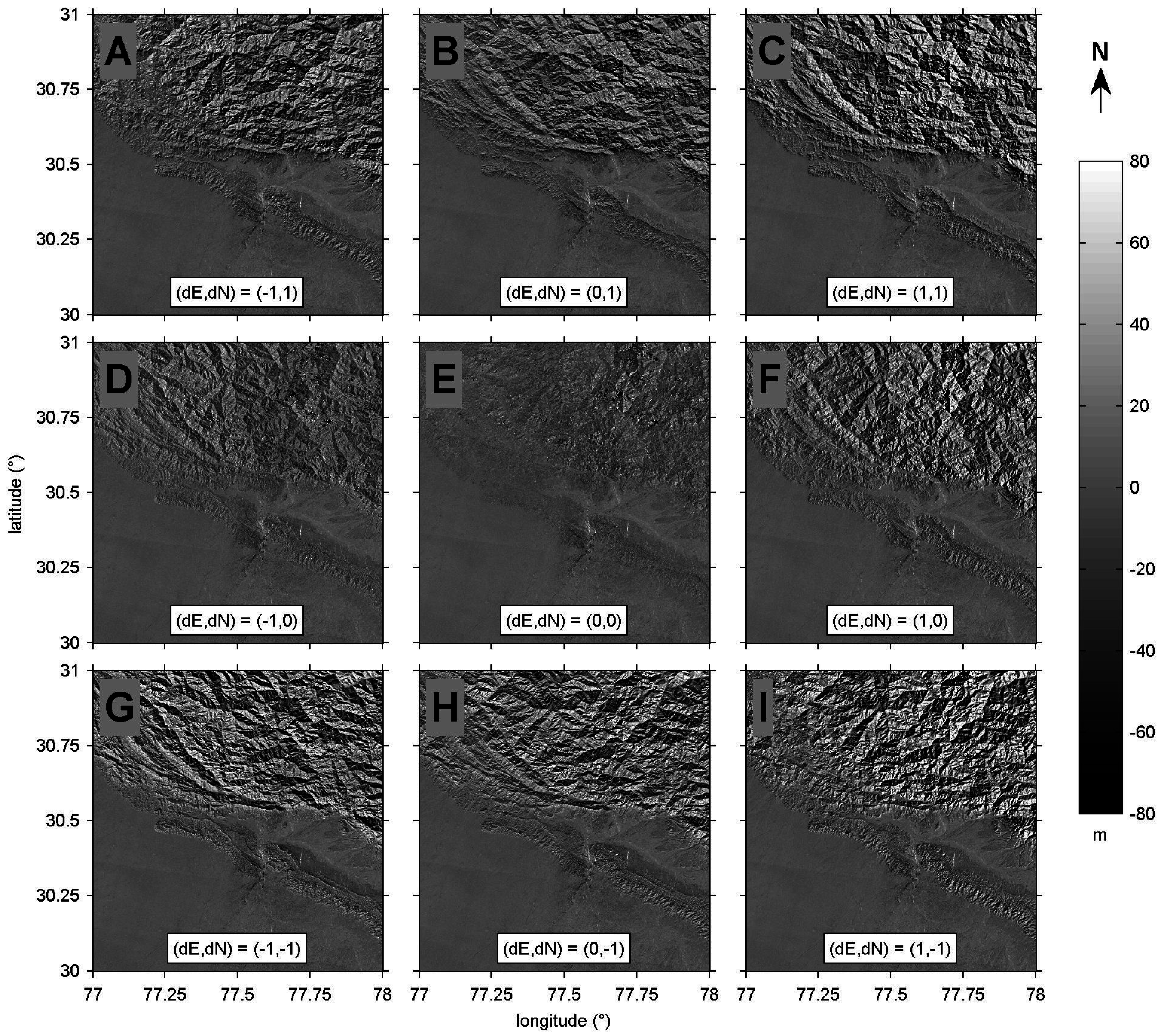
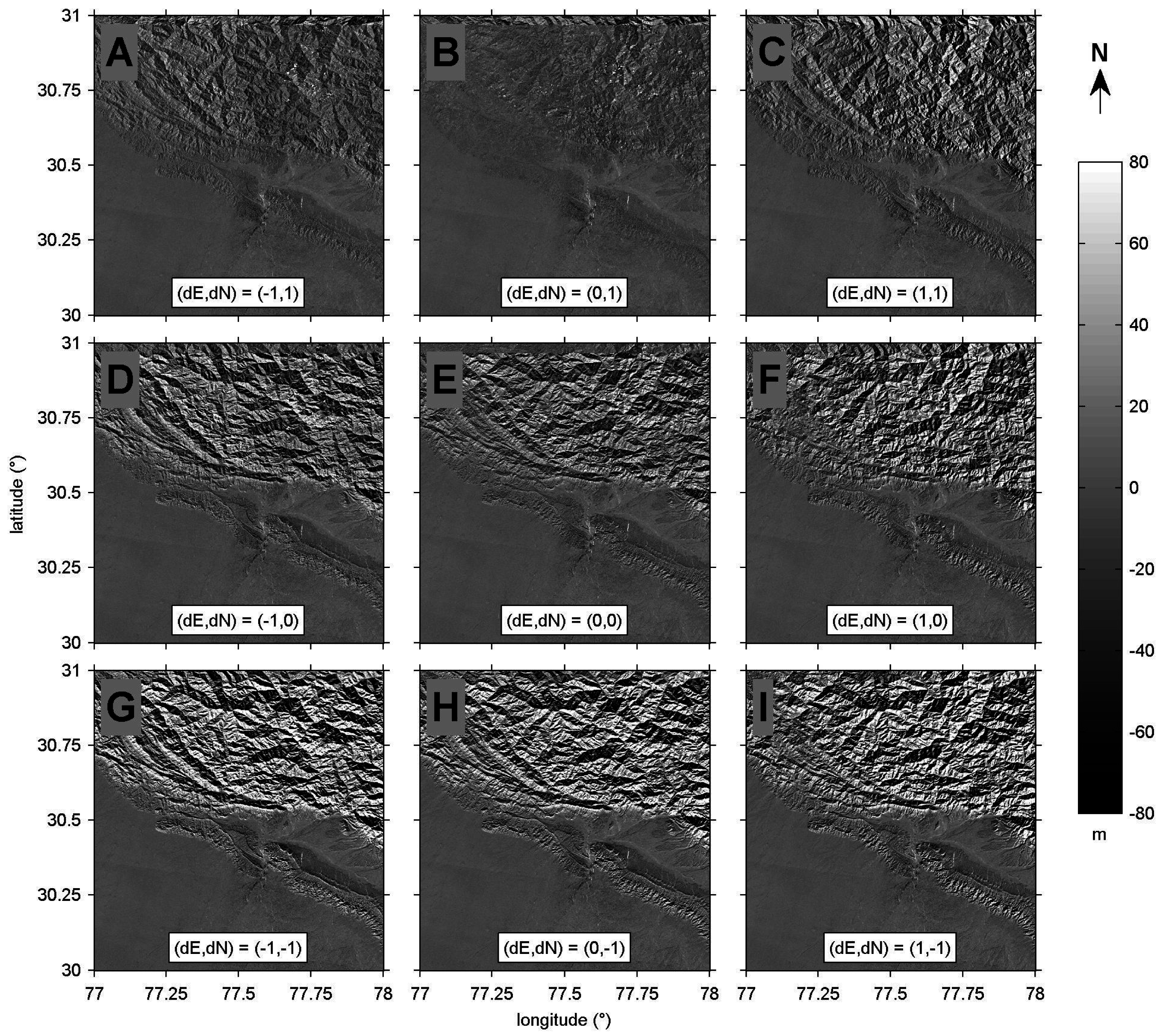
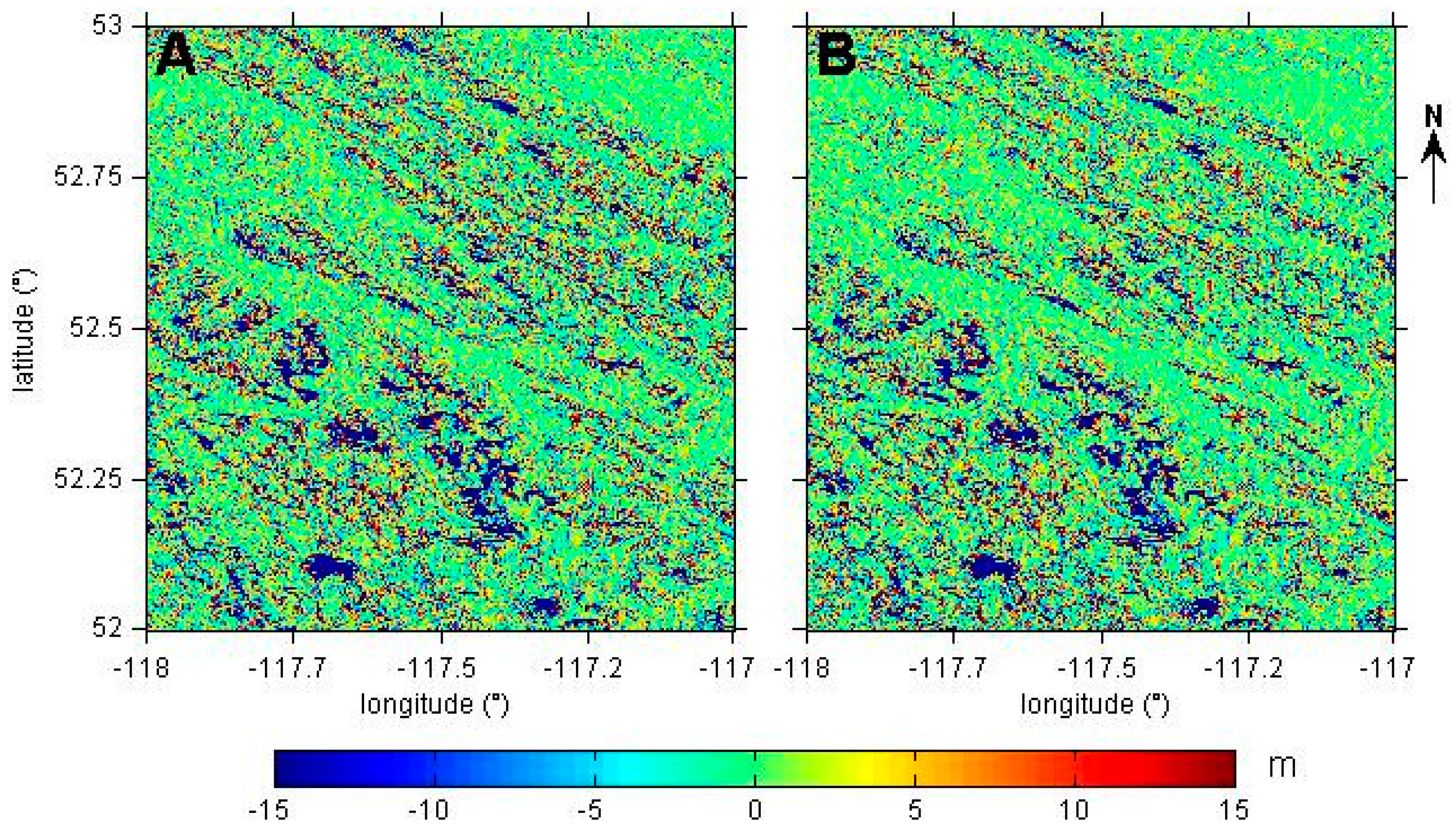
| Description | Difference Category | ||
|---|---|---|---|
| Type I | Type II | Type III | |
| SRTM-CGIAR-v4.1 tile | 52_06 | 52_06 | 13_02 |
| SRTM-NASA-v2.1 tile | N31E076 | N30E077 | N52W118 |
| dE (pixels) a | 0 | 0 | 0 |
| dN (pixels) b | 0 | 1 | 0 |
| µdh (m) c | 0.00 | −0.04 | −0.02 |
| σdh (m) d | 0.30 | 6.84 | 4.84 |
| Mindh (m) e | −58 | −171 | −278 |
| Maxdh (m) f | 59 | 217 | 297 |
| Valid pixels g (%) | 99.42 | 99.64 | 96.55 |
| Identical pixels h (%) | 99.65 | 96.81 | 32.9 |
© 2016 by the author; licensee MDPI, Basel, Switzerland. This article is an open access article distributed under the terms and conditions of the Creative Commons Attribution (CC-BY) license (http://creativecommons.org/licenses/by/4.0/).
Share and Cite
Merryman Boncori, J.P. Caveats Concerning the Use of SRTM DEM Version 4.1 (CGIAR-CSI). Remote Sens. 2016, 8, 793. https://doi.org/10.3390/rs8100793
Merryman Boncori JP. Caveats Concerning the Use of SRTM DEM Version 4.1 (CGIAR-CSI). Remote Sensing. 2016; 8(10):793. https://doi.org/10.3390/rs8100793
Chicago/Turabian StyleMerryman Boncori, John Peter. 2016. "Caveats Concerning the Use of SRTM DEM Version 4.1 (CGIAR-CSI)" Remote Sensing 8, no. 10: 793. https://doi.org/10.3390/rs8100793




